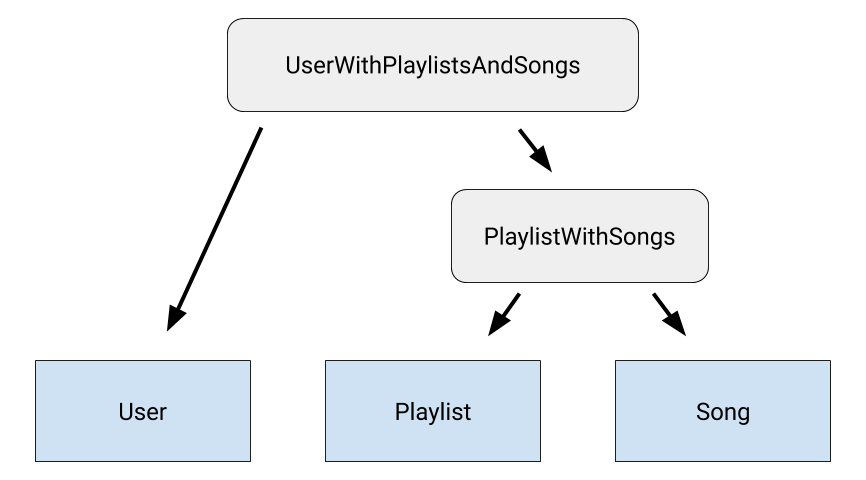Sometimes, you might need to query a set of three or more tables that are all related to each other. In that case, you define nested relationships between the tables.
Suppose that in the music streaming app example, you want to query all the users, all the playlists for each user, and all the songs in each playlist for each user. Users have a one-to-many relationship with playlists, and playlists have a many-to-many relationship with songs. The following code example shows the classes that represent these entities as well as the cross-reference table for the many-to-many relationship between playlists and songs:
Kotlin
@Entity
data class User(
@PrimaryKey val userId: Long,
val name: String,
val age: Int
)
@Entity
data class Playlist(
@PrimaryKey val playlistId: Long,
val userCreatorId: Long,
val playlistName: String
)
@Entity
data class Song(
@PrimaryKey val songId: Long,
val songName: String,
val artist: String
)
@Entity(primaryKeys = ["playlistId", "songId"])
data class PlaylistSongCrossRef(
val playlistId: Long,
val songId: Long
)
Java
@Entity
public class User {
@PrimaryKey public long userId;
public String name;
public int age;
}
@Entity
public class Playlist {
@PrimaryKey public long playlistId;
public long userCreatorId;
public String playlistName;
}
@Entity
public class Song {
@PrimaryKey public long songId;
public String songName;
public String artist;
}
@Entity(primaryKeys = {"playlistId", "songId"})
public class PlaylistSongCrossRef {
public long playlistId;
public long songId;
}
First, model the relationship between two of the tables in your set as you
normally do, using a data class and the @Relation annotation. The
following example shows a PlaylistWithSongs class that models a many-to-many
relationship between the Playlist entity class and the Song entity class:
Kotlin
data class PlaylistWithSongs(
@Embedded val playlist: Playlist,
@Relation(
parentColumn = "playlistId",
entityColumn = "songId",
associateBy = Junction(PlaylistSongCrossRef::class)
)
val songs: List<Song>
)
Java
public class PlaylistWithSongs {
@Embedded public Playlist playlist;
@Relation(
parentColumn = "playlistId",
entityColumn = "songId",
associateBy = Junction(PlaylistSongCrossRef.class)
)
public List<Song> songs;
}
After you define a data class that represents this relationship, create another
data class that models the relationship between another table from your set and
the first relationship class, "nesting" the existing relationship within the new
one. The following example shows a UserWithPlaylistsAndSongs class that models
a one-to-many relationship between the User entity class and the
PlaylistWithSongs relationship class:
Kotlin
data class UserWithPlaylistsAndSongs(
@Embedded val user: User
@Relation(
entity = Playlist::class,
parentColumn = "userId",
entityColumn = "userCreatorId"
)
val playlists: List<PlaylistWithSongs>
)
Java
public class UserWithPlaylistsAndSongs {
@Embedded public User user;
@Relation(
entity = Playlist.class,
parentColumn = "userId",
entityColumn = "userCreatorId"
)
public List<PlaylistWithSongs> playlists;
}
The UserWithPlaylistsAndSongs class indirectly models the relationships
between all three of the entity classes: User, Playlist, and Song. This is
illustrated in figure 1.

If there are any more tables in your set, create a class to model the relationship between each remaining table and the relationship class that models the relationships between all previous tables. This creates a chain of nested relationships among all the tables that you want to query.
Finally, add a method to the DAO class to expose the query function that your
app needs. This method requires Room to run multiple queries, so add the
@Transaction annotation so that the whole operation is performed
atomically:
Kotlin
@Transaction
@Query("SELECT * FROM User")
fun getUsersWithPlaylistsAndSongs(): List<UserWithPlaylistsAndSongs>
Java
@Transaction
@Query("SELECT * FROM User")
public List<UserWithPlaylistsAndSongs> getUsersWithPlaylistsAndSongs();
